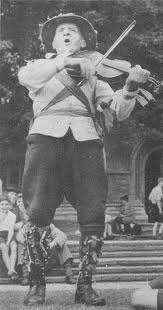Annotation:Lively Jig (The)
Back to Lively Jig (The)
LIVELY JIG, THE. AKA - "4-Lady." AKA and see "Wonder Hornpipe (The)." English, Morris Dance Tune (4/4 time). F Major. Standard tuning (fiddle). AABB. Collected from the village of Ilmington, Warwickshire, in England's Cotswolds, although Bacon says the dance probably originated outside of the village (opining "not 'Ilmington' in character"). The Ilmington morris tradition was not constant, and in fact died and was revived several times during the 19th and 20th centuries. The revival of 1908 was led by fiddler Sam Bennett, who took some remembered tradition from the previous revival some 25 years before, and added a number of dances and tunes from elsewhere (he had accompanied Headington Quarry dances in 1907). “The repertory as noted was ‘Bumpas o’ Stretton (Morris on), Maid of the Mill, Black Joke, Old Mother Oxford, Shepherd’s Hey, Constant Billy and The Buffoon.’ Of these seven, only four correspond with those given as featuring in the repertory of the Ilmington side in 1886." Bennett not only employed imported material, but seems to have added some of his own choreographic elements, which earned the denunciation of collector Cecil Sharp as "untraditional," supported by complaints about his revival side by three older dances active in the 1886 incarnation. Bennet's team survived until the First World War.

"The Lively Jig" is a handkerchief dance four four--"men", states Bacon, although there is evidence (including photographic) the it was introduced by Bennet for a ladies side. However, it was not a dance recorded in the older Ilmington repertoire, and may have originated from Blackwell or Stretton-on-the-Fosse [1].
Source for notated version:
Printed sources: Bacon (The Morris Ring), 1974; p. 222.
Recorded sources:
